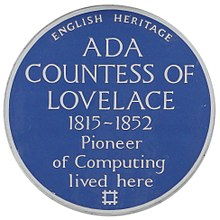Ada Lovelace
Augusta Ada King, Countess of Lovelace (10 December 1815 – 27 November 1852) was an English mathematician and writer who wrote the world's first computer program.
Ada Lovelace | |
|---|---|
 | |
| Born | 10 December 1815 London, England |
| Died | 27 November 1852 (aged 36) Marylebone, London, England |
| Nationality | British |
| Scientific career | |
| Fields | Mathematics, computing |

Achievements
changeLovelace was an English writer. She became the world's first computer programmer. She wrote the program for Charles Babbage's mechanical computer, "The Analytical Engine", in 1844. She wrote the first algorithm to be processed by a machine.
Between 1842 and 1843 she translated an article by Italian mathematician Luigi Menabrea on the engine. She added her own notes to it. These notes contain what is considered the first computer program, which was an algorithm encoded for processing by a machine. Though Babbage's engine was never built, Lovelace's notes are important in the early history of computers.[1]
She realized that computers would be able to do more than just calculating or number-crunching. Others, including Babbage himself, worked only on the possibilities of calculations.[2][3]
Childhood
changeShe was born 10 December 1815. She was the only legitimate child of Lord Byron and Anne Isabella Milbanke. She had no relationship with her father, who died when she was nine. Her father was a poet. Her mother was an aristocrat, which is someone who was related to royalty. Ada was educated at home. As a young adult, she was interested in mathematics, partly because of Charles Babbage.[4]
Later life
changeLovelace married William King in 1835. She had three children with him. She soon got cholera, a digestive disease caused by drinking contaminated water. She was very lucky to have survived. She also had asthma, a breathing issue, and digestive problems. She used painkillers to treat her problems. Because of this, she became addicted to opium, a highly addictive drug. She died on 27 November 1852, of uterine cancer in London.
Recognition
changeThe U.S. Department of Defense named Ada (programming language) in her honor.
References
change- ↑ Essinger, James 2014, Ada's algorithm: how Lord Byron's daughter Ada Lovelace launched the digital age, Melville House Publishing, ISBN 978-1-61219-408-0
- ↑ Fuegi J. & Francis J. 2003. Lovelace & Babbage and the creation of the 1843 'notes'. Annals of the History of Computing, 25 (4): 16–26. [1]
- ↑ Schlager, Neil and Lauer, Josh (eds) 2001. Emergence of women at the highest levels of mathematics. In Science and Its Times, vol. 6, Gale. Student Resources in Context, link.galegroup.com/apps/doc/CV2643450645/SUIC?u=palo88030&xid=35975d1c. Accessed 29 Mar. 2017.
- ↑ Spicer, Dag. "Lovelace, Ada." World Book Advanced, World Book, 2017, www.worldbookonline.com/advanced/article?id=ar738619. Accessed 29 Mar. 2017.
Other websites
change- Women in science. [2] Archived 2018-12-25 at the Wayback Machine
- Ada Byron, Lady Lovelace. [3]